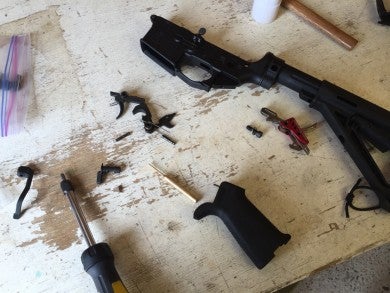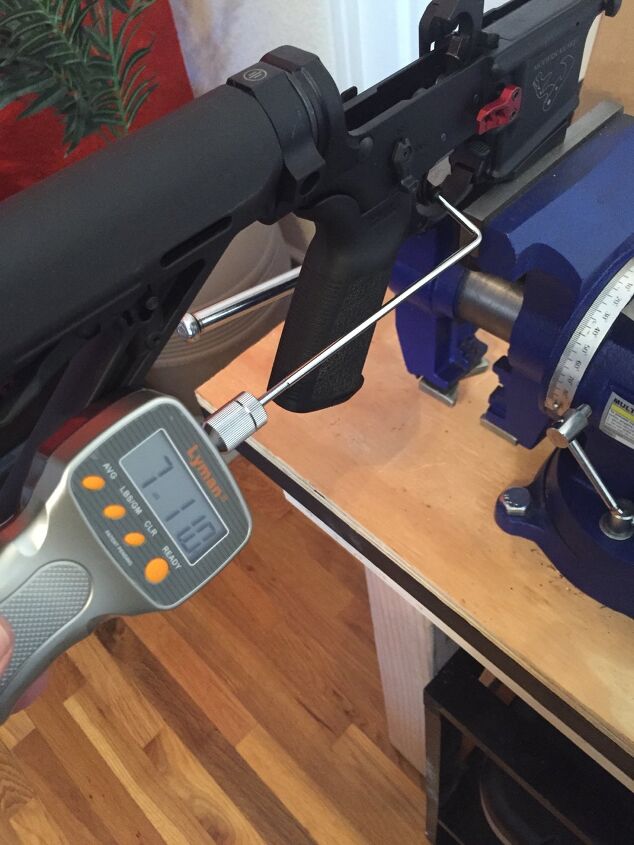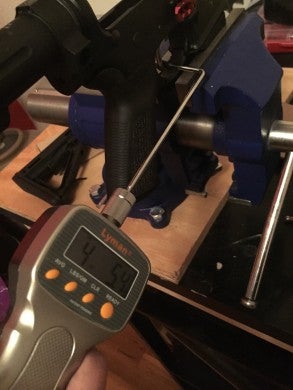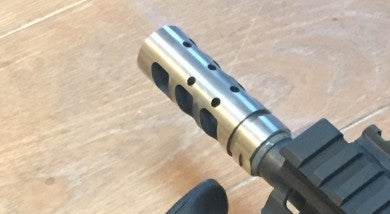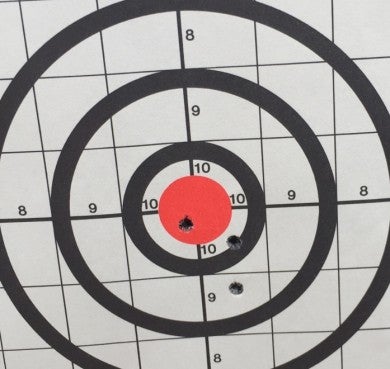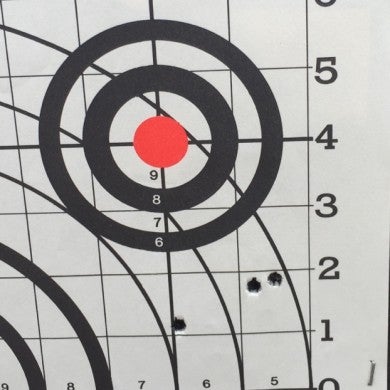As indicated in my brief post from SHOT, I was getting the opportunity to review a trigger and compensator from RISE Armament. About two weeks after SHOT I received a care package from them, and it contained their RA-535 Advanced Performance Trigger and RA-701 Compensator (as well as a KNS Trigger Pin Kit).
Observations
Overall I am pretty impressed with both components. This is the first after-market trigger I’ve installed and run on any platform. While I have had the opportunity to review a bunch of different muzzle devices recently, the RISE 701 is definitely a top contender.
RA-535 Advanced Performance Trigger
With a crazy-fast reset, nearly nonexistent over-travel, and a smoother, crisper, lighter trigger pull, the RA-535 Advanced Performance Trigger (APT) helps you fire more quickly and accurately. The single-stage trigger group is easy to install.
The original trigger on the PWS Modern Musket is the ALG QMS Trigger (while not explicitly stated in their literature, I’m pretty sure it is single stage). It is pretty decent trigger without much slop and comes in about a 7-lb pull. The RISE Trigger is advertised as a single-stage trigger with a 3.5-lb pull.
I removed the original trigger without much difficulty, not even having to use much force—I was able to extract the hammer and trigger pins out with hand force and a punch.
Installation of the RISE 535 is simple. Seriously a sub ten-minute job if you have a stock rifle. After you pull your original trigger, you just drop the RISE in place, install the pins (kit or otherwise—which I will explain in a minute), and replace your safety lever and grip. Give it a quick function check and hit the range. I’m not going to go too heavily into that—there are tons of YouTube videos on pulling a trigger. I actually swapped mine out at the range.
The only problem I had was installing the trigger with the KNS trigger pin kit. The issue is that the kit components are not flush with the lower receiver body. I have an Odin Works XMR-RED (extended magazine release) installed, and the sideplates of the KNS kit are raised enough that they interfere with depressing the button. Which, of course, I didn’t realize until after I had installed the trigger and pin kit.
I was just going to scrap the Odin Works XMR during the course of the review, when Romo (from BMC) suggested that I check the body of the trigger and see if the RISE 535 had trigger lock screws that could extend out the bottom (much like a Timney Trigger I am told). Sure enough! Inside the trigger body (looking from the top) are a couple of holes (one on each side) where you can insert a hex-head wrench and extend the screws.
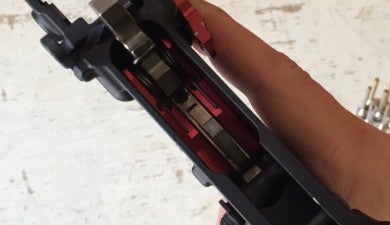
If you look close you can see the ports in the red anodized aluminum just forward of the ends of the spring tails.
I removed the KNS pin kit and reinstalled my original trigger and hammer pins. Then with a little bit of cursing and expeditious use of a jeweler screw driver (to lift the trigger spring out of the way) I was able to access the trigger lock screw holes. It took a few turns and then there was enough tension to lock the trigger and hammer pins in place. (I imagine this could potentially be problematic with a polymer lower, so be careful, or extend the screws with the trigger body removed from the receiver).
The trigger is super crisp. It took a little bit to get used to the vertical trigger (having always shot one with a defined curve). After finding my finger placement, it just felt much more natural. There was very little noticeable travel and the reset was quick. I did a rapid shot (in the video lower down in the article), and I think my muscle twitch was slower than the trigger’s ability to reset. Seriously fast trigger.
I did my shoot and after getting back home, I mounted the lower in my vise (using a magazine well vise block) so that I could check the trigger pull weight. Using a Lyman Electronic Digital Trigger Pull Gauge, I measured an average of 5.0-lb (over 10 pulls).
I also had my wife repeat the measurement just to provide confirmation (she came out at 4.54-lb).
Another buddy of mine bought the RISE 535 Trigger based on playing with mine at the range, and he came over for some help installing it. Just for grins, we measured his and it averaged a 5.1-lb pull.
KEY FEATURES (from RISE Website)
- Single-stage
- 3.5-lb. pull weight
- Quick reset for faster response time between shots
- Lightened trigger pull with super-crisp release to improve accuracy and increase target acquisition
- Combines straight trigger functionality and comfort with curved control
- Self-contained design makes it easy and quick to install with no fine-tuning needed
- KNS pins included
- Manufactured and assembled in our facility according to strict AS9100 aerospace requirements, which are more stringent than standard gun manufacturing requirements
- Quality-assured with high-tech inspection equipment that can measure up to five decimal places—two beyond the standard and far more precise than the human eye can detect
- Precision CNC machined from high-grade, heat-treated tool steel and aluminum
- Contained in RISE Armament’s signature bright red 8625 hardcoat anodized aluminum housing
RA-701 Compensator
Designed to counteract recoil and lifting tendencies, the RA-701 Compensator helps you stay on target for fast follow-up shots.
Installing the compensator was easy. It did not come with a new crush washer, but fortunately those are cheap and readily available. It is important to make sure that when you install a new muzzle device you put it on correctly, especially given that a bunch of the “compensator” type devices are designed with specific venting ports configured to vent in specific directions. This doesn’t mean hand tightening it–it means you need to crank it down and lock it in place and ensure that it has the correct orientation. Otherwise you run the chance of venting gases in some unintended direction and potentially experiencing unexpected behavior or movement. The RISE definitely has a “correct” orientation as it has an asymmetric pattern of vents on the top.
Because different devices on the end of your rifle change the way that gases are expelled, it is important that you correct for any differences that may appear as a result. For example, I started with my Primary Weapons Systems Modern Musket in it’s original configuration (with the PWS FSC Muzzle Device) and zeroed it at 100 meters (close enough for this purpose anyways). I had a GripPod installed as a front resting point, and was shooting Hornady 75 gr Boat Tail Hollow Points. For my optic, I upgraded to a Leupold Mark AR MOD 1 1.5-4x20mm scope after having a seriously annoying problem with my Lucid HD7 (the optic that came with the Modern Musket). Basically the changeable reticle on the HD7, a feature I really dislike everywhere it is used (by any manufacturer) was no longer positively locking in place on the 2MOA red dot. Which means I had no consistent point of impact based on my point of aim. Ask me how many rounds I fired and trips back and forth to the end of the hundred meter, zero-wind tunnel I made… Did I also mention my spotting scope is currently non-functioning? Anyone else ever have range days like that?
I installed the RA-701 after two sets of shots on the target.
Then I fired two more groups.
As you can see, the shots dropped nearly two inches and pulled to the right and inch and a half. What does that mean in regards to the RA-701? Nothing, since it was consistent. I just need to re-zero my optics for it. It does re-emphasize the point that anytime you change a component of your weapon that has the potential to modify the flight path of your round (gas dispersion, barrel length changes, etc.), you should re-zero it. That should be obvious, but I think it is worth restating.
The above narrative really doesn’t evaluate the operation of the RA-701, I just wanted to walk you through the process I used to make sure I was zeroed with it. The real value of a “compensator” is its ability to mitigate the natural rise of the barrel after shots. The above test was done with single shot from a stable shooting platform. I would expect consistency when doing that.
How I decided to test out the compensation was to dump a few magazines as rapidly as possible. What I found with the RA-701 is that it did an amazing job of compensating for movement during rapid fire. I think the below video demonstrates the RISE compensator and trigger (the movement is more me than the rifle—I did my best putting am overlay line on the video as a reference point).

The tight circles are from the above video (ignore the fatter circles–I didn’t pull it down before my buddy took some pistol shots at it). Shots were from around 30 meters as fast as I could pull the trigger.
The only downside to this compensator is that it puts out a little bit of concussive “love” to anyone standing next to you. Not a terrible amount, but enough to notice. And really, given how these things operate you would expect that kind of behavior—the gases have to go somewhere…
KEY FEATURES (from RISE Website)
- 416 stainless steel
- Designed to counteract recoil and lifting tendencies
- Length: 2.5”
- Weight: .2 lbs.
- .223 Remington / 5.56 NATO
- Designed to fit standard ½-28 TP barrel
Conclusion
Based on my time reviewing both of these (as well as comments from a couple of other people that fired my rifle with them installed—one of whom has since bought both the trigger and compensator), I heartily recommend both products.
The combination of the trigger and compensator allowed for extremely rapid and accurate followup shots. I haven’t noticed an awesome decrease of my time during 3-Gun (in the 2 matches where I used them), but that is more likely related to my crappy shotgun reloading skills than an issue with the RISE components.
The biggest issue I found was a difference in the stated trigger pull weight and what I measured. But at the end of the day, that made no difference to me. The trigger was super crisp, had a short reset and just overall felt good.
The trigger itself also just looks good. The lines and angles are clean, and I like the attention to detail with the polish and color—even though those are things that no one is going to see. The compensator I was sent was in Stainless Steel and that starts to show fouling pretty rapidly. If you are the type that would be bothered by that (and that doesn’t also clean equipment like an OCD monkey) they make a version in black.
The RISE RA-535 Advanced Performance Trigger retails for $259 and the RISE RA-701 Compensator retails for $129 ($139 for black).
You can order both items from their website at:
http://www.risearmament.com/
 Your Privacy Choices
Your Privacy Choices

